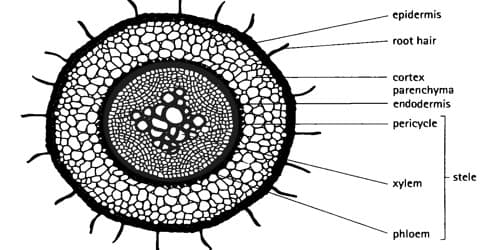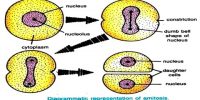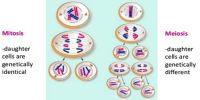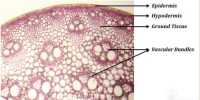The plants whose seeds have only one cotyledon are called dicots. The formation of the dicot root varies significantly from that of the monocots.
Identifying characteristics of the internal structure of dicot root:
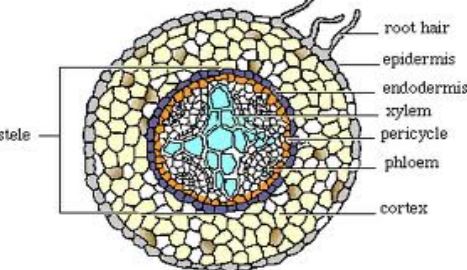
- The cuticle is absent in the epiblema and well fitted with unicellular root hairs.
- Endodermis consists of one-layered cells and Casparian strips are present in endodermal cells. It consists of barrel-shaped compressed parenchymatous cells. It contains both Casparian stripes and passage cells.
- The pericycle is composed of one-layered cells. Pericycle uniseriate and become meristematic to give secondary roots and secondary tissues.
- Vascular bundles are radial; Xylem is exarch, a number of xylem bundles vary from 2 to 4 rarely more (up to 6-8). Metaxylems are angularly arranged in linear. Vascular bundles are two to six in number
- Xylem is exarch type i.e. proto-xylem is situated towards the periphery
- The medulla is very small.
- Cortex is homogenous (without differentiation).
- Pith is very small or completed obliterated. The function of pith is Storage of water and food.
Internal Structure of Dicot root –
The internal structure of a typical dicot root shows following features:
(1) Epidermis: Epidermis is the outermost layer of the stem and it is sole layered and lack of chloroplast. It plays a significant role in protection. Root hairs increase the absorbing surface of the root.
(2) Cortex: It divided into three parts; (a) Hypodermis: It is present just below the epidermis. It provides additional support to epidermis. It is a thick multicellular layer, green and photosynthetic. (b) General Cortex: Storage of food is the main function of the cortex. The deepest layer of the cortex is called endodermis. (c) Endodermis: It is a single-celled wide layer. The cells of endodermis are container shaped. These cells accumulate more starch in the stem of a dicot.
(3) Pericycle: This layer is positioned in between the endodermis and vascular bundles. The pericycle of the stem is multilayered and made up of sclerenchyma.
(4) Vascular Bundle: The vascular bundles (wedge-shaped) are arranged in a ring. Each vascular bundle is made of phloem, cambium, and xylem.
(5) Pith: This is a well-developed area, spreading from the ring of the vascular bundle to the center. This occupies only a small area in the center of the root. The cells of this region mostly made up of parenchyma.
Dicot roots show the following distinct anatomical features –
- A number of vascular bundles vary from 2-6.
- The pith is either reduced or absent.
- Old roots exhibit secondary growth.
